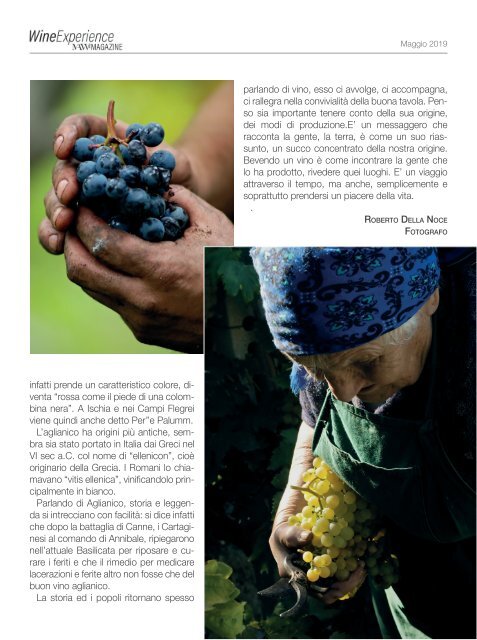Wine Experience - Aprile 2019
Wine Experience-MAVV Magazine è la nuova rivista che il Museo dell’Arte, del Vino e della Vite dedica alle eccellenze enologiche. Con una pregevole veste grafica, la rivista digitale, in formato pdf e con testo inglese a fronte, intende presentare ad una platea internazionale di appassionati ed operatori del settore le migliori produzioni italiane, raccontando i territori di provenienza e dando voce agli imprenditori e le alte professionalità impegnate in questo settore. In una parola WINE EXPERIENCE intende valorizzare la grande cultura del vino, il gusto e lo stile ad esso collegato.
Wine Experience-MAVV Magazine è la nuova rivista che il Museo dell’Arte, del Vino e della Vite dedica alle eccellenze enologiche. Con una pregevole veste grafica, la rivista digitale, in formato pdf e con testo inglese a fronte, intende presentare ad una platea internazionale di appassionati ed operatori del settore le migliori produzioni italiane, raccontando i territori di provenienza e dando voce agli imprenditori e le alte professionalità impegnate in questo settore. In una parola WINE EXPERIENCE intende valorizzare la grande cultura del vino, il gusto e lo stile ad esso collegato.
Create successful ePaper yourself
Turn your PDF publications into a flip-book with our unique Google optimized e-Paper software.
Maggio <strong>2019</strong><br />
parlando di vino, esso ci avvolge, ci accompagna,<br />
ci rallegra nella convivialità della buona tavola. Penso<br />
sia importante tenere conto della sua origine,<br />
dei modi di produzione.E’ un messaggero che<br />
racconta la gente, la terra, è come un suo riassunto,<br />
un succo concentrato della nostra origine.<br />
Bevendo un vino è come incontrare la gente che<br />
lo ha prodotto, rivedere quei luoghi. E’ un viaggio<br />
attraverso il tempo, ma anche, semplicemente e<br />
soprattutto prendersi un piacere della vita.<br />
.<br />
ROBERTO DELLA NOCE<br />
FOTOGRAFO<br />
WINE, THE SOUL OF THE LAND<br />
There are many ways to identify a territory, looking at<br />
its people, its traditions, its history, its culture and much<br />
more. Many aspects that connote a land, making it unique<br />
and, almost always, immediately recognizable.<br />
There is a common thread through the centuries, adapting<br />
to the main flow of culture and needs. I thought of<br />
taking one of these threads starting a work on native<br />
grapes.<br />
The wine accompanies man for millennia.<br />
The scent, the taste, its color vary sometimes from one<br />
hill to another, characterizing it to the finest palates in<br />
an unmistakable way. All this in my photos is not there,<br />
it does not have to be there, the title of the exhibitionin<br />
his wordplay clearly states it. The vitality of the wine can<br />
not be enclosed in a photograph, the wine must be tasted,<br />
it must be smelled. The relationship must be physical<br />
and direct. I then tried to visually bring back only<br />
what was before, perhaps also to expand the knowledge<br />
and share it, just as you do with a good glass of<br />
wine.<br />
I followed the producers learned many things that I did<br />
not know and that, in their simplicity, fascinate me and<br />
come back to my mind every time I look at a vineyard.<br />
In my photographs I tried to reproduce the grapes in its<br />
magnificent simplicity; the work, commitment, love and<br />
care that peasants and producers have in cultivating it.<br />
While I was photographing, I listened to their stories,<br />
their experiences, their differences and points of view<br />
on production.<br />
infatti prende un caratteristico colore, diventa<br />
“rossa come il piede di una colombina<br />
nera”. A Ischia e nei Campi Flegrei<br />
viene quindi anche detto Per’’e Palumm.<br />
L’aglianico ha origini più antiche, sembra<br />
sia stato portato in Italia dai Greci nel<br />
VI sec a.C. col nome di “ellenicon”, cioè<br />
originario della Grecia. I Romani lo chiamavano<br />
“vitis ellenica”, vinifi candolo principalmente<br />
in bianco.<br />
Parlando di Aglianico, storia e leggenda<br />
si intrecciano con facilità: si dice infatti<br />
che dopo la battaglia di Canne, i Cartaginesi<br />
al comando di Annibale, ripiegarono<br />
nell’attuale Basilicata per riposare e curare<br />
i feriti e che il rimedio per medicare<br />
lacerazioni e ferite altro non fosse che del<br />
buon vino aglianico.<br />
La storia ed i popoli ritornano spesso



